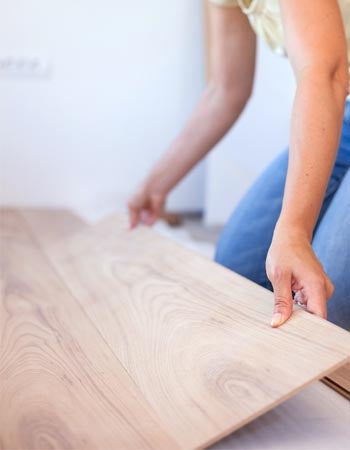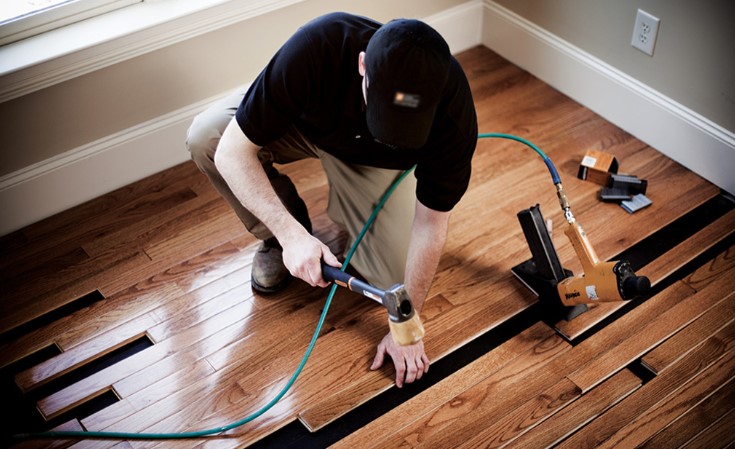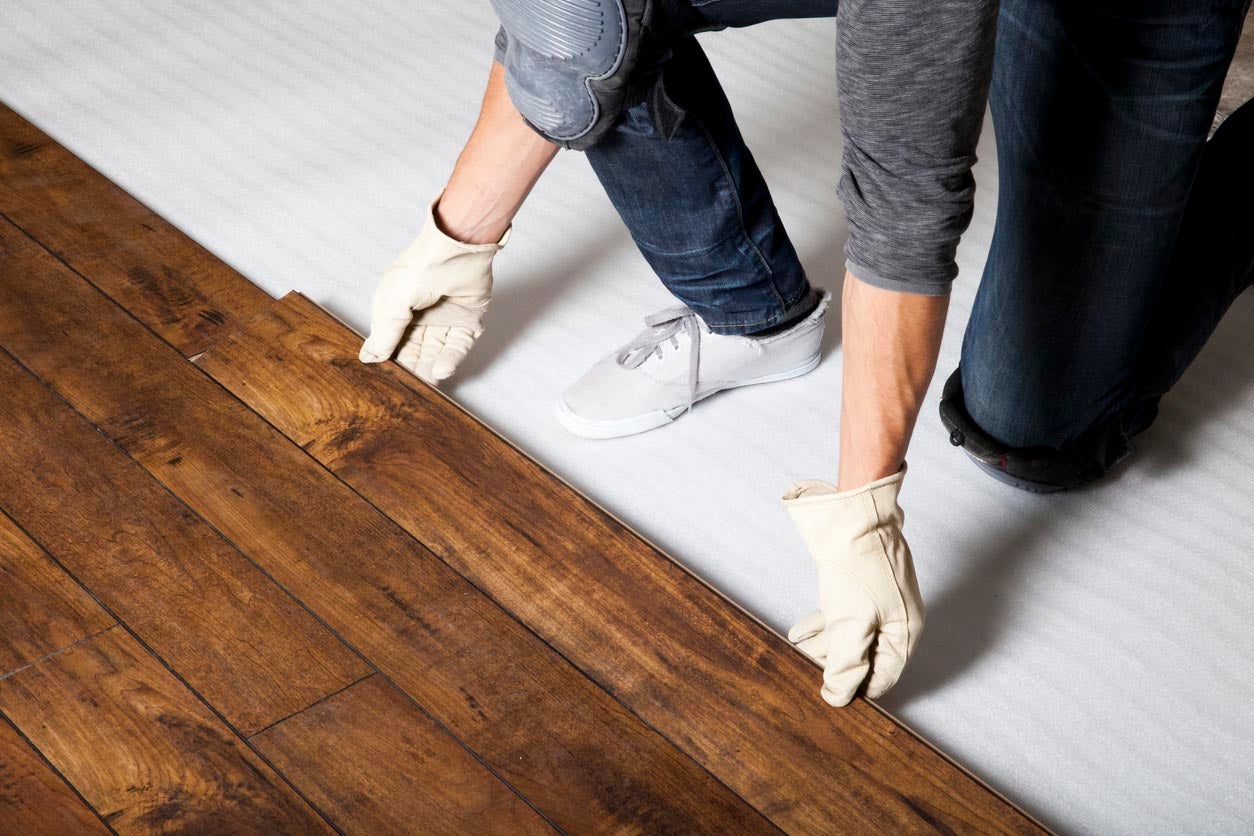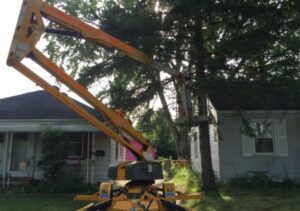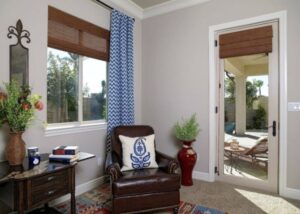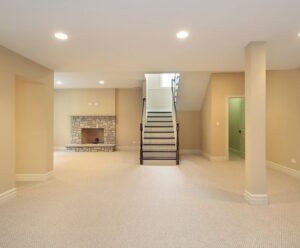How Much Does It Cost to Install Vinyl Plank Flooring? (2023)

- Typical Range: $952 to $3,755
- National Average: $2,349
Vinyl plank flooring can be installed over existing flooring without needing to be glued or nailed down since it snaps together edge to edge. It’s common to use vinyl plank flooring as a faux wood floor option. Since it can be reinforced with urethane, it’s scratch- and stain-resistant. According to HomeAdvisor, the cost to install vinyl plank flooring ranges between $952 and $3,755, with the national average at $2,349. Vinyl plank flooring costs approximately $2 to $10 per square foot installed, and luxury vinyl plank flooring costs between $1 and $6 per square foot for materials, plus $1 to $5 per square foot for labor. Vinyl plank flooring is considerably more expensive than other vinyl sheet flooring that can run from $0.50 to $2 per square foot. Vinyl flooring professionals typically charge around $36 per hour, or $1 to $5 per square foot for labor, not including the materials needed for the project. Many homeowners choose to install vinyl flooring一whether it is vinyl planks, sheet, or tile一because it’s water-resistant, low maintenance, cost-effective, durable, long-lasting, and comfortable underfoot.

Carpet, hardwood, vinyl, and tile flooring.
Bob Vila has partnered with Empire Today to help you easily get beautiful new floors at a great price.
Free In-Home Estimates
What Is Vinyl Plank Flooring?
Vinyl planks are available in varying thicknesses, with the thicker planks being more expensive but easier to install. Vinyl plank flooring is designed to click together, so it doesn’t have to be nailed or glued down. Thinner planks are more difficult to click together and install, which can significantly increase labor costs. Vinyl planks are waterproof and require less maintenance, so they’re a fantastic alternative to hardwood flooring since they have a natural-looking wood grain, and they work well as a floating floor over a concrete subfloor. Luxury vinyl planks are a higher-quality flooring material. The planks are thick, and they have a durable, long-wearing top layer. Luxury vinyl planks have more realistic wood grain and give the appearance of natural hardwood flooring. They also click-lock together and work well over any type of subfloor.
Vinyl Plank Flooring vs. Luxury Vinyl Tile
Like vinyl planks, luxury vinyl tiles come in different thicknesses. Vinyl tile is durable and an outstanding choice for flooring in areas with high moisture. The tile shape successfully mimics stone or wood tiles since it has embossed design patterns. It has a thicker top layer, and it can also be treated with urethane for more scratch and stain resistance. Vinyl tiles are easier to replace than vinyl planks and sheet vinyl. The price of luxury vinyl tile depends on the size and pattern of the flooring.
Vinyl Plank vs. Vinyl Sheet
Vinyl sheet flooring is one of the most budget-friendly flooring materials. Vinyl sheet flooring comes in precut sheets or rolls that are 6 or 12 feet wide. Certain types of sheet flooring require it to be glued down on only the edges, and others need to be glued down completely. The cost averages between $0.50 and $1 per square foot. Sheet vinyl is also stain- and scratch-resistant and waterproof. It is a superb option for high-moisture areas, and it also has fewer seams than vinyl plank installation. One downside of vinyl sheet flooring is that it’s difficult to replace since the entire sheet will need to be removed.
Factors in Calculating Cost to Install Vinyl Plank Flooring
Calculating the cost to install vinyl plank flooring depends on several factors. Prices can differ from the national average due to labor costs in your area, materials, quality, geographic location, installation method, plank thickness, and core construction.
Labor
A vinyl flooring contractor charges approximately $36 an hour to install vinyl plank flooring. This averages out to $1 to $5 per square foot, not including the cost of the flooring materials. Labor prices can vary from the norm due to the cost of labor in the home’s area. Labor costs in large cities are typically higher than in more rural areas of the country.
Interested in installing vinyl plank flooring?
A top-rated pro can help you pick the flooring that’s right for your home. Get free, no-commitment project estimates from experts near you.
+
Materials and Quality
The quality of the vinyl materials will affect the overall cost of the flooring installation. Printed vinyl flooring has the color and pattern printed on a layer of paper affixed to the top layer of vinyl but below the finished surface. This type of flooring has varying levels of quality, with a higher level of quality at a more expensive price point. Most sheet vinyl, vinyl composition tile (VCT), and plank vinyl are printed and typically cost between $1 and $7 per square foot. Inlaid vinyl flooring is created by driving color granules through the top layer of vinyl. This method gives the flooring more depth, detail, and texture than printed vinyl flooring. Luxury plank vinyl and tile use this technique to produce realistic stone and wood patterns. Inlaid vinyl flooring costs between $5 and $12 per square foot.
Geographic Location
The geographic location of the home will affect the overall cost to install vinyl plank flooring. Labor fees and material prices will vary from the national average depending on the cost to move and deliver materials. Higher costs of living typically dictate higher labor fees.
Installation Method
The installation method of vinyl plank flooring can affect the overall price of the flooring project. There are three ways to install plank flooring: a floating floor, a peel-and-stick floor, and a glue-down floor. The glue-down method takes more time and is more labor intensive, so it’s the most expensive option. A floating floor is the most budget-friendly method of installation.
Plank Thickness
High-end vinyl planks are more expensive because of how thick they are. The thicker the plank and the wear layer are, the sturdier and longer lasting it will be. While 5 millimeters is a suitable thickness, 8 millimeters is considered the best. Any planks under 3 millimeters should only be used in areas that don’t see much foot traffic. It’s recommended that the wear layer be 12 mils (as in a thousandth of an inch) or more. For busy homes and high-traffic areas, a thickness of 20 millimeters or thicker is suggested.
Interested in installing vinyl plank flooring?
A top-rated pro can help you pick the flooring that’s right for your home. Get free, no-commitment project estimates from experts near you.
+
Core Construction
Vinyl plank flooring has either a flexible or rigid core. Flexible core vinyl flooring is vulnerable to warping and bending when placed in direct sunlight. It needs a level and smooth subfloor to ensure the best installation.
Rigid core vinyl flooring is a stable and durable option. The additional rigid layer makes it more expensive, but it is easy to maintain. Rigid core planks have a solid center that creates a more realistic wood-like feel. It comes in various textures, colors, and styles that can simulate the look of hardwood and vinyl. It’s sturdy and better cushioned than other vinyl flooring. One of the biggest advantages of rigid vinyl planks is that they’re 100 percent waterproof. There are two types of rigid vinyl flooring, and their prices range from $3.50 to $12.
- Wood plastic composite core (WPC). WPC costs between $4 and $12 per square foot for materials. It has a vinyl surface with a wood plastic composite core. The solid core is waterproof, and it won’t warp or ripple. The vinyl layer is protected by a wear layer that protects it from scratches. It comes in a variety of patterns and designs, and it’s perfect to use with uneven subfloors.
- Stone plastic composite core (SPC). Also called stone polymer composite, SPC costs between $3.50 and $7 per square foot for materials. Many homeowners use SPC to mimic the look of natural stone or wood in their homes. It’s suitable for high-traffic areas since it’s so durable.
Additional Costs and Considerations
There will be additional price factors and considerations when budgeting for the cost to install vinyl plank flooring. These include the removal of old flooring, underlayment, trimming, design, stairs, and warranty.
Removing Old Flooring
Removing old flooring costs $1 to $2 per square foot. Installing a new floor costs approximately $36 per hour and could take upwards of a few days. If the homeowner decides on a non-floating floor, it will take longer to finish the job, with labor costs in the thousands. If the existing flooring was glued down by an adhesive and was installed in the 1980s or earlier, there is a good chance the adhesive contains asbestos. Homeowners are advised to call a professional to get it tested so it can be removed properly.
Interested in installing vinyl plank flooring?
A top-rated pro can help you pick the flooring that’s right for your home. Get free, no-commitment project estimates from experts near you.
+
Underlayment
Some vinyl flooring professionals recommend using an underlayment beneath vinyl flooring. Using an underlayment is beneficial if you want to reduce noise and make the surface more comfortable. This typically costs $0.50 per square foot. Thicker vinyl floors that are floated do not need an underlayment.
Trimming
Trim and molding hide gaps near the walls after vinyl flooring has been installed. It provides a consistent look by pulling together the flooring and the rest of the room. Some homeowners will reuse the old trim and only pay for labor costs for the reinstallation. Another option is to purchase new trim. Prices can vary based on the trim type and how much area needs to be covered.
Design
Vinyl plank flooring comes in a variety of designs, patterns, and colors. Since the design is printed on the top layer, the patterns and colors can fade over time. Down the line, the homeowner may need to replace some of the planks, especially in high-traffic areas.
Laying vinyl planks in custom designs will increase costs. Custom designs will require more preparation, different materials, and more labor.
Stairs
Installing vinyl plank flooring on stairs is time-consuming and labor-intensive. The planks need to be cut to size, and trim will be required to hide the edges. More trim results in more money spent on materials.
Warranty
When you consider that vinyl planks cannot be refinished, purchasing a warranty on vinyl flooring may be worth the extra cost. Some vinyl plank flooring brands offer a warranty on materials, and reputable contractors will guarantee their work.
Cost to Install Vinyl Plank Flooring Types
Vinyl plank flooring is installed in one of three ways, each with its own benefits.
Interested in installing vinyl plank flooring?
A top-rated pro can help you pick the flooring that’s right for your home. Get free, no-commitment project estimates from experts near you.
+
Floating Floor
This is the cheapest option of the three at the low end of the cost spectrum for labor. A floating floor clicks together edge to edge and doesn’t need to be glued or nailed to a subfloor. The existing floor doesn’t need to be removed, which can help save additional money.
Peel-and-Stick
Peel-and-stick vinyl planks have an adhesive on the back that will stick to the subfloor. While adhering the vinyl planks to the subfloor is easy, the prep is not. Peel-and-stick vinyl planks are a flexible core product. Flexible core flooring needs a strong and even subfloor to adhere correctly, or else it will bend and warp if the subfloor is not perfectly level. Peel-and-stick vinyl planks are in the mid-price range of labor for this installation method.
Glue-Down
Gluing down individual vinyl planks is the most expensive installation option. Glue-down installations are costly because they’re so labor intensive. Keep in mind that the price of a glue-down installation for vinyl plank flooring is similar to the price range for engineered hardwood flooring. If you’re interested in low-VOC vinyl flooring, the glue used to affix it is typically high in VOCs, which can make this installation method not eco-friendly.
Benefits of Choosing Vinyl Plank Flooring
Choosing a new type of flooring for your home can feel overwhelming. It can be challenging to compare the pros and cons of different flooring options with so many choices available, including other composite choices, such as laminate flooring. Vinyl plank flooring has become a favorite of homeowners for many reasons, including that it successfully mimics the natural look of stone and wood.
Hardwood Flooring Alternative
With vinyl plank flooring, you can get the look of hardwood without the price. Vinyl plank excels at imitating many types of wood flooring. Many homeowners prefer vinyl plank flooring since it’s more affordable to install than hardwood, it doesn’t require special maintenance.
Waterproof
One of the most significant benefits of vinyl plank flooring is that it’s waterproof. However, you’ll still want to avoid pooling water on the vinyl plank floor since it can seep through and damage the subfloor, underlayment, and insulation.
Customizable Aesthetic
With vinyl plank flooring, you can get any look you want in your home. If you prefer lighter woods or dark ones, you can create the aesthetic you want without breaking the bank. Creating a custom design in vinyl plank flooring will also save more money than doing a custom design in hardwood.
Durability
Vinyl plank flooring can be as durable as hardwood flooring for a fraction of the price, depending on the quality. It can withstand high-traffic residential and commercial environments.
Interested in installing vinyl plank flooring?
A top-rated pro can help you pick the flooring that’s right for your home. Get free, no-commitment project estimates from experts near you.
+
Economical Cost
Vinyl plank flooring is attractive to homeowners since the materials are less expensive than hardwood, and it costs less to install. If a vinyl plank is damaged, it’s easy to replace and match the existing flooring.
Easy Installation
A floating click-lock vinyl plank floor is relatively easy to install. Peel-and-stick and glue-down floors are more complex and time intensive. Keep in mind that subfloor prep and accurate plank cutting are essential to easy installation.
Low Maintenance
Compared to other types of flooring, vinyl plank flooring is easy to maintain. Regular cleaning is recommended to keep scratches and damage at bay. Vacuuming or sweeping will eliminate dirt and debris, and mopping with hot water and vinegar will cut the dirt and grime without streaks.
Cost to Install Vinyl Plank Flooring: DIY vs. Hiring a Professional
Installing vinyl plank flooring as a DIY project is an option. Vinyl plank flooring is one of the easiest flooring materials to install on your own. While you can save money by installing the planks yourself, mistakes can be costly. It also takes more than just the flooring planks for installation. Keep in mind that the estimated cost for materials and tools for a 500-square-foot DIY project is around $3,300. Professional flooring contractors can complete the installation in less time, and many reputable contractors will warranty their work.
How to Save Money on Vinyl Plank Flooring Installation
The cost to install vinyl plank flooring can be high, and the additional costs associated with the project can quickly add up. One way to save on the cost of vinyl plank flooring is to buy the cheapest materials, but there are other ways to save without compromising quality.
- Get multiple estimates. Request at least three estimates from reputable flooring contractors in your area. The cheapest bid may save you money up front, but the contractor dedicated to quality workmanship will take the correct steps to ensure the job is done right.
- Choose the right material for you. Knowing what type of wear and tear your flooring will face will help save money in the long run. If you buy a cheaper material and it wears out fast, you’ll end up spending more money in the long run on replacement materials.
- Maximize your budget. Sticking to your budget and maximizing scheduling and timing will help avoid wasted hours. This is why hiring experienced flooring contractors is the best idea.
- Look for deals. Some flooring suppliers may offer sales or discounts. Do your research and get the best possible price for your flooring.
Interested in installing vinyl plank flooring?
A top-rated pro can help you pick the flooring that’s right for your home. Get free, no-commitment project estimates from experts near you.
+
Questions to Ask About Vinyl Plank Flooring Installation
Asking a professional the right questions about the cost to install vinyl plank flooring can minimize miscommunication, save money, and get the desired results. Here are some questions to ask a vinyl plank flooring professional.
- Are you licensed and insured?
- Do you have workers’ compensation?
- How long have you been installing vinyl plank flooring?
- Do you have references?
- Does the estimate include subfloor preparation costs?
- How long will the flooring installation take?
- Who will install the floor?
- Will you dispose of the old flooring?
- How will you handle cleanup?
- What kind of warranties do you offer?
FAQs
Deciding on new flooring while staying within your budget can be a daunting process. Here are some frequently asked questions about vinyl plank flooring to help guide you in your decisions.
Q. How much does it cost to install 1,000 square feet of vinyl flooring?
On average, it can cost between $2,000 and $7,000 to install vinyl flooring in a 1,000-square-foot space. This price is for materials only, and it does not include labor.
Q. How long does it take to install vinyl planks?
How long the project takes depends on the size of the space and the installation method. Click-lock planks are the easiest to install, and the glue-down process will take longer.
Q. Can I place my refrigerator on top of vinyl plank flooring?
Vinyl plank flooring is durable, and heavy appliances such as a refrigerator will not damage the flooring.
Q. How do I clean my vinyl plank flooring?
It’s recommended to vacuum or sweep the flooring regularly and mop with hot water and vinegar. For stubborn marks or stains, dish soap can be added to the water.
Sources: HomeAdvisor, Fixr


